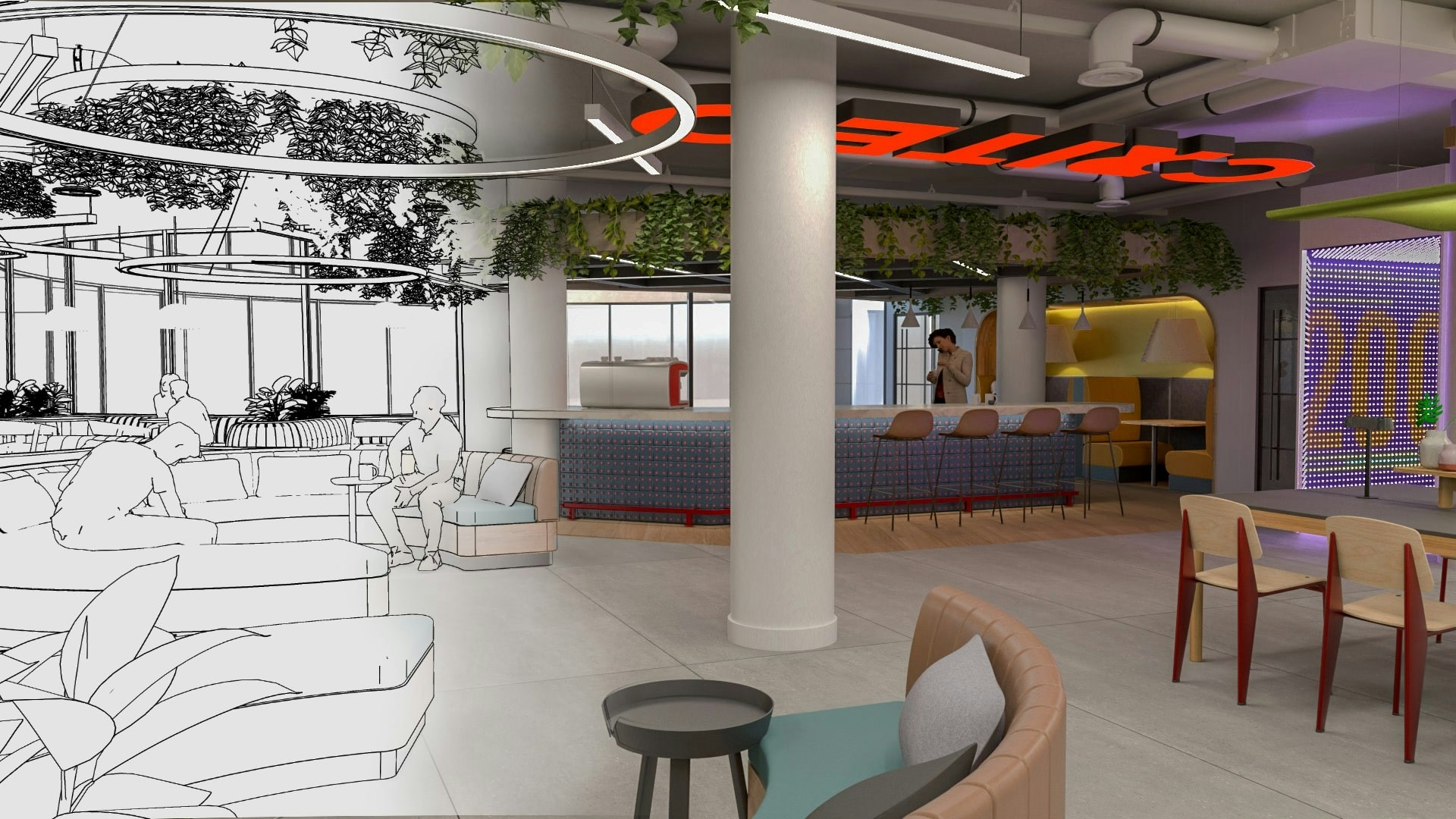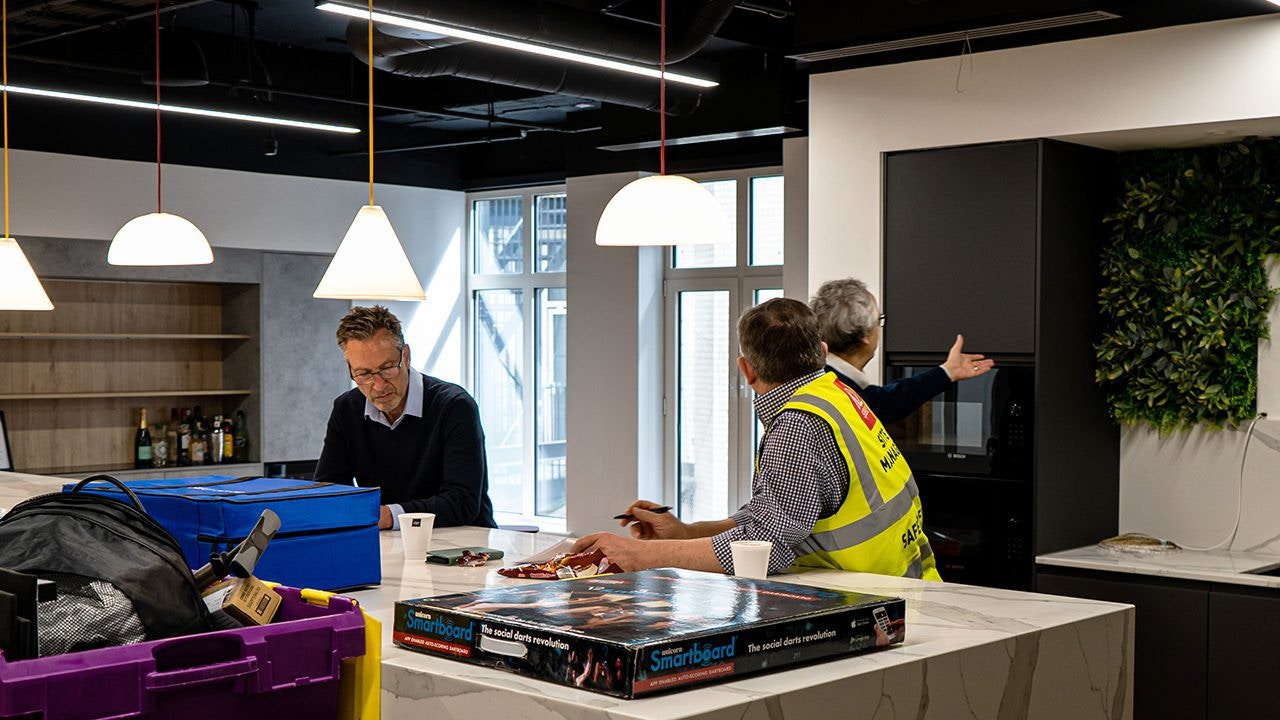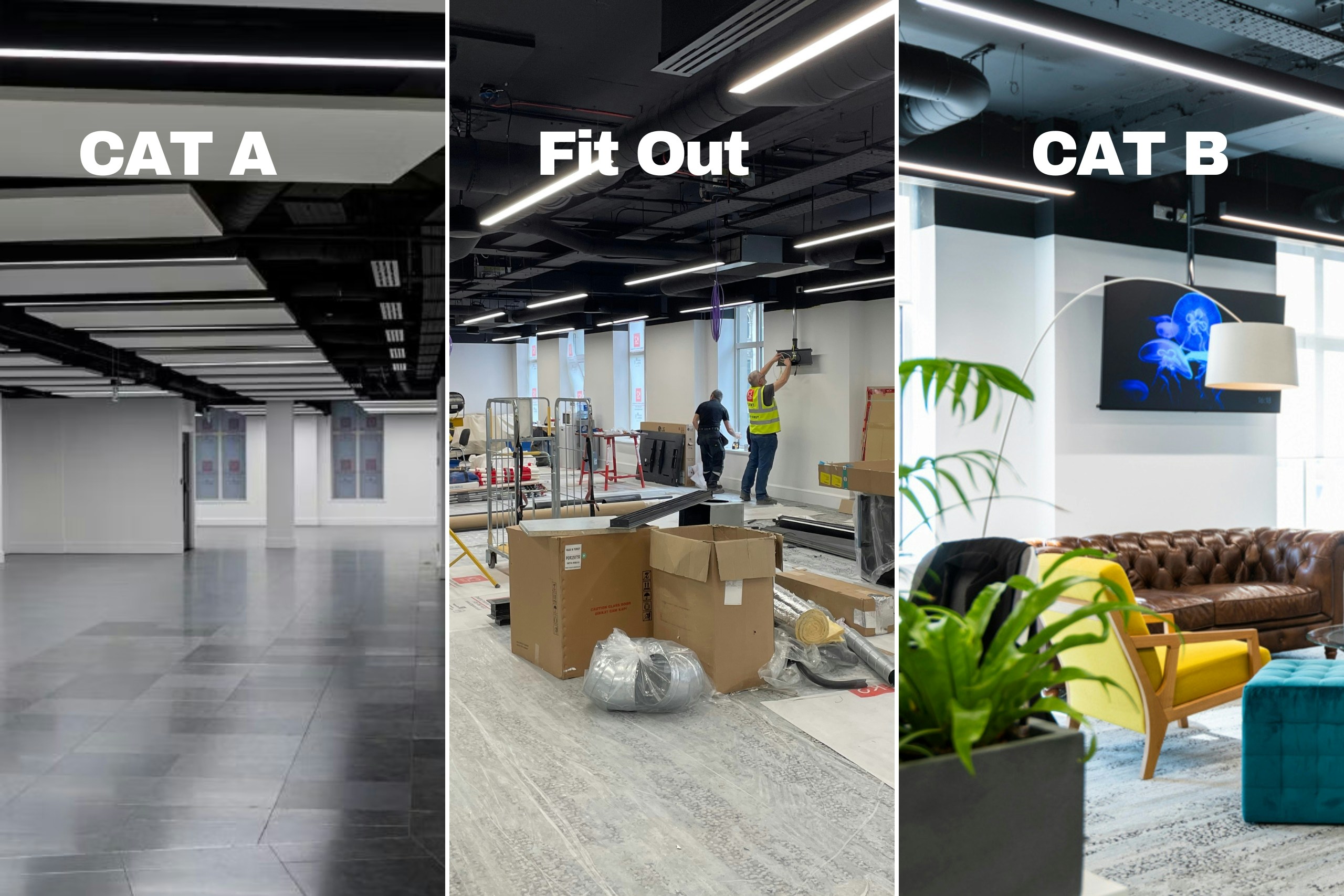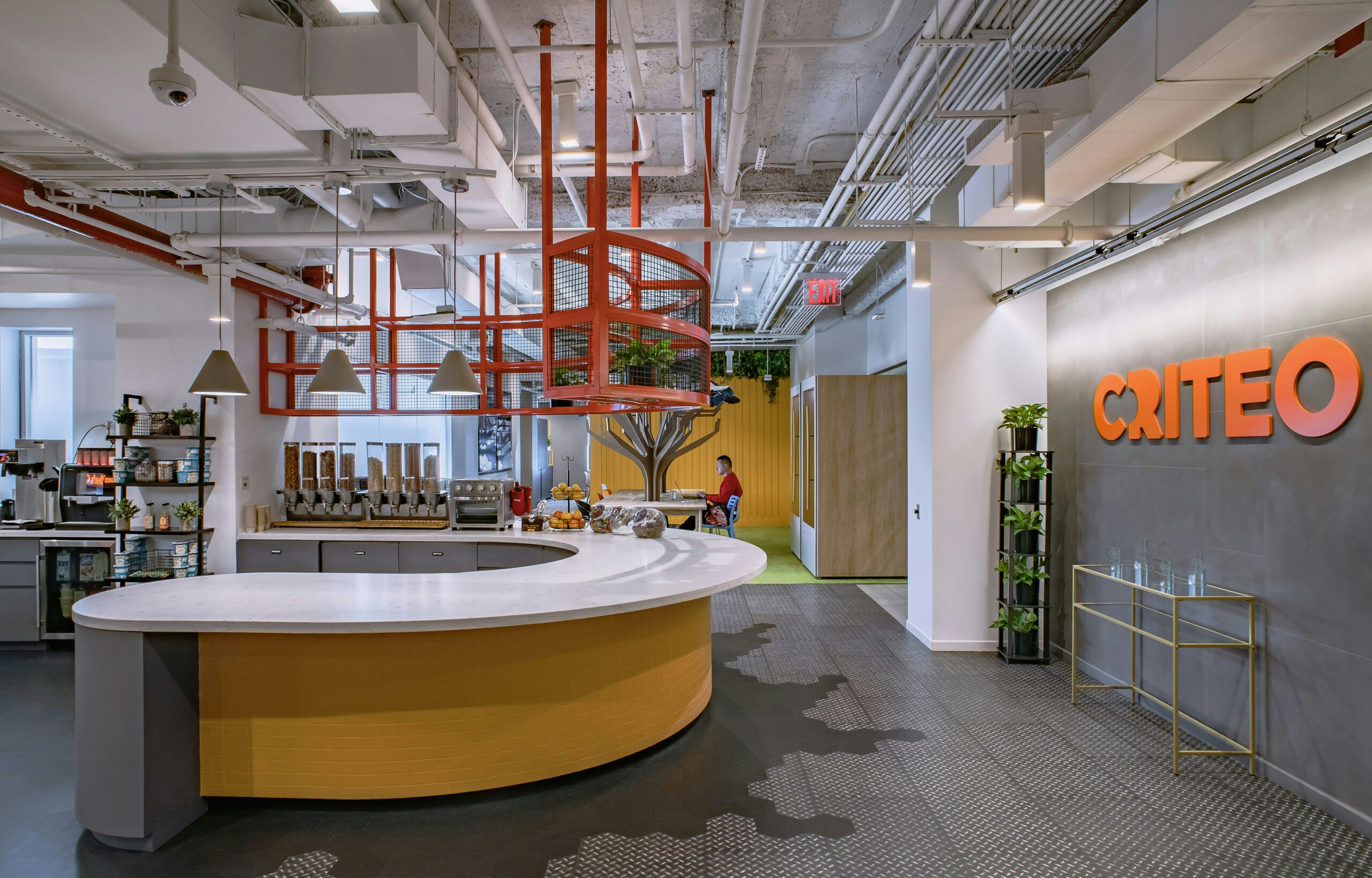- What is an Office Fit-Out?
- When Do You Need a Fit Out?
- What are the Types of Office Fit Outs?
- What is a CAT A Fit Out?
- What is a CAT A+ Fit Out?
- What is a CAT B Fit Out?
- What is the Office Fit-Out Process?
- What are the Key Considerations for a Successful Office Fit-Out?
- Are You Considering an Office Fit Out?

What Exactly is an Office Fit-out?
What is an Office Fit-Out?
An office fit-out is the transforming of an empty or basic office shell into a fully functional and operational workspace which is ready for occupation by a company and its staff, and that aligns with a company’s specific needs and brand identity. This includes everything from the installation of facilities like bathrooms to raised floors, and the creation of meeting rooms, breakout areas, and kitchens.
During the office fit-out process, a bare, uninhabitable area is transformed into a fully functional workplace, replete with furniture, HVAC, tea points, AV, workstations, and other necessities.
The significance of a well-executed office fit out by a team of fit out experts is imperative to the continued success of business. It plays a vital role in enhancing employee productivity, morale, and overall workplace well-being.
By thoughtfully designing and equipping an office space with the right mix of work areas, collaborative spaces, and amenities, businesses can foster a more engaged and motivated workforce. Moreover, a workspace that accurately reflects a company’s brand identity can leave a lasting impression on clients and visitors, reinforcing the brand’s values and professional image.
From the installation of essential services like electrical, plumbing, and HVAC systems to the selection of finishes and furniture that reflect the brand’s palette and values, every element of an office fit-out needs to be meticulously planned and executed. The goal is to create a functional office space that enhances productivity and embodies the company’s unique brand identity.


When Do You Need a Fit Out?
Deciding when to undertake an office fit out can be crucial for a business, and it has an impact on everything from employee satisfaction to operational efficiency. In our experience, clients have many different reasons for engaging in an office fit out. Here are some common scenarios we’ve found that necessitate a fit-out:
Company Growth
As a business expands, its spatial needs change. A good example of this is our longstanding client DTRE who recently moved from a 7,000 sq ft space near Bond Street to a much larger 11,000 sq ft. space in Mayfair to meet the needs of a growing team. Growth might indeed mean more employees, which requires additional workspaces, or even specialised areas like touchdown areas for clients, new meeting rooms or breakout areas. An office fit-out helps in redesigning the space to accommodate these needs efficiently, while at the same time futureproofing the space to support the growing increased headcount.
Downsizing
A decision to downsize can come either due to market conditions or a strategic decision to become more streamlined; for example, the existing office space might become excessive or poorly configured. Downsizing became a trend following the pandemic as many companies readjusted to staff working from home. A fit-out in this case can help optimise the use of space, reduce costs, and maintain or even enhance productivity in a smaller footprint.
Rebranding
A rebrand is often more than just a marketing overhaul – it can signify a company’s new direction or philosophy. The physical office space should reflect this change. A fit-out can align the work environment with the new brand identity, making it tangible for both employees and visitors. This alignment can include updates to the colour scheme, office layout, and even the furnishings to better reflect the company’s updated brand and values.
Tech Upgrades
In an era where technology evolves rapidly, offices might need a fit-out to integrate new technologies. This can include creating spaces for video conferencing, enhancing IT infrastructure, or building tech-savvy collaborative areas that facilitate seamless digital interaction.
Lease Milestones
The beginning or end of a lease can be a strategic moment for an office fit-out. Companies might choose this time to renew and revamp their office space to secure a better lease term or to make the space more marketable.
Legal and Compliance Updates
Regulatory changes can also prompt a fit-out. For example, updates in health and safety laws, accessibility requirements, or energy efficiency standards might require physical changes to the office environment.
Each of these scenarios represents a strategic point where a company can significantly benefit from an office fit-out, ensuring that the workspace not only meets current needs but is also poised to handle future challenges.


What are the Types of Office Fit Outs?
There are several types of “Fit Outs,” that come in various states of completion: from an empty “shell” of a building to a blank canvas space ready to fit out with glass walls, and bespoke kitchens. It’s good to become familiar with fit out types to help navigate your project and its requirements. We’ve included a comprehensive guide to office fit-outs below explaining not just the meaning of the term “office fit out” but also the steps it entails.
When referring to the process of preparing an interior space for office use, the word “fit out” is often used to describe the installation of all the essential structural, electrical, furniture, decorative, and mechanical elements. In other words, the office is outfitted with furniture, décor, and mechanical and electrical services equipment according to the requirements of the tenant.
The goal of an office fit-out is to create a working environment that is conducive to the demands of the company or individuals who will be using the space. It’s important to distinguish between an office fit-out and an office renovation. To fit out an office is to create a new working environment from the ground up.

What is a CAT A Fit Out?
A CAT A is the basic finish of an office following the building construction – the shell and core. CAT A’s are generally commissioned by landlords who lease the building on to tenants, who in turn fit it out the office space to meet their bespoke requirements. This is not to be confused with a “Grade A” which refers to the quality of the building. CAT A (or Category A fit out) is the basic finish after the completion of the shell and core. A CAT A fit out is still essentially a blank canvas or “White Box” with an open-plan finish. This is still a relatively rough standard. It’s not suitable for tenants to move in as such.
A CAT A finish typically includes:
- Installation of basic mechanical and electrical and plumbing services
- Standard lighting installation
- Raised floors and suspended ceilings
- Heating, Ventilation and Air-conditioning (HVAC)
- Fire detection services and smoke alarms (which are essential for the health and safety of the building)
- Basic internal finishes
If you were walking around a CAT A finish you would notice a very plain-looking space with evenly spaced lighting and metal blocks of the raised floor. The raised floor is essentially a set of high-density particleboards with a steel wraparound on the top and a steel sheet at the bottom, all a uniform size of 60 x 60 cm, and laid out in a grid pattern across the entire floor. Lifting a section of these blocks would expose a space underneath (around 10-25 cm in height) which is supported by pedestals. This allows computer and electrical cables to pass under the floor to respective workstations and other areas of the office.
Note: At this point, there is no partitioning of the office space. Landlords may require at the end of the tenancy that the office space be returned to CAT A finish. This requires separate cost and timescale considerations for dilapidations.
Transition from From CAT A to CAT B
The example shows a transition from a CAT A fit out with raised floor for easy access of electrical wiring, data cabling to beautifully furnished CAT B fit out with herringbone flooring, iconic soft seating, benching, lighting and lush greenery in crate shelving.


What is a CAT A+ Fit Out?
A CAT A+ sits midway between a CAT A and CAT B. It emerged as a landlord’s response to serviced office and co-working spaces (the likes of WeWork and Regus). Tenants who are less inclined to take long leases have the option of a plug-and-play office setup that comes already fitted out to a generic level but without the bespoke design elements, fittings, and choices of exactly how they want the office laid out.
CAT + Fit Outs typically include:
- Fitted kitchens and tea points
- Partitioning for meeting rooms, breakout areas, and offices
- Furniture
- Workstations
- Re-routed Air Conditioning
- Power sockets
- IT Infrastructure
The CAT A+ model is not suitable for all companies. Many companies wish to create their own customised space to fit the company culture. If the company brand and culture are important elements to you and you want to retain a unique corporate identity, the CAT B fit out is more appropriate.

What is a CAT B Fit Out?
A CAT B fit out (also known as a Category B fit out) follows on directly from a CAT A fit out to provide completed ready-to-use office space. In contrast to the CAT A+ which provides a generic usable space (common with co-working and serviced offices), a CAT B is a space that is tailored to the requirements of a particular company brand. This is a particularly favourable option if you’re looking to take out a long-term lease and you want to separate and distinguish your branded workspace from others.
In contrast to a CAT A+, there are numerous advantages that a CAT B fit out affords its tenants:
- A unique, professionally designed office space with purpose-built areas
- A choice of functional and aesthetic interior fittings
- A more integrated design that augments your company’s brand identity
- Better utilisation of space, which comes from the ability to carefully space plan the office from a blank canvas CAT A fit out.
- Less wastage from renovating an already complete and standardised office space.
- Cost savings in not having to reconfigure ventilation ducting and mechanical and electrical systems.
As a tenant, you want a space that is designed and fitted out to motivate, energise and inspire your workforce. The design and layout of this space need to be considered alongside all sorts of practicalities, like the number of staff working at the office and working from home (see our article on hybrid office design), and the arrangement of heating, ventilation and air conditioning (HVAC) in the suspended ceiling so that it reaches each workstation.
In addition, there are considerations of workplace well-being such as breakout areas and the use of plants in various parts of the office (see our article on biophilic office design). Ultimately the Cat B design and fit out should work to improve staff performance, aid retention, and generate efficiencies within a company. This, in a nutshell, is what a CAT B fit out has to offer. So where does it start, and how do you achieve it?
The CAT B starts essentially where the CAT A ends. It covers everything from interior partitioning (the creation of meeting rooms, boardrooms etc.) to the design of ceilings, walls, doors, reception areas, break-out areas, kitchens, tea points, quiet spaces, and various other essential parts of the modern office.
Before a CAT B commences, a company needs to decide whether to go the traditional route, by partnering with an architect, builders, and various other parties, or to use the design and build route (D&B) where a single office fit out company is selected to look after every detail, from space planning and 3D designs to the choice of furniture, interior design, build work and final finishes. The Design and Build (D&B) model is becoming far more popular as it saves time and avoids complications where otherwise multiple independent contractors are involved.

What is the Office Fit-Out Process?
1. Constructing a Brief
The journey begins with an in-depth meeting aimed at understanding your vision, goals, budget, and aspirations for the office design and fit-out. This foundational stage is essential for crafting a comprehensive and customised brief, ensuring the outcome aligns with your expectations. Through active listening and targeted questions, we capture the essence of your envisioned space, setting a solid groundwork for the project that perfectly balances functionality with aesthetics.
2. Understanding Your Space
Armed with a detailed brief, our next step focuses on familiarising ourselves with the physical attributes of your office space. Through site visits, surveys, and evaluations, we assess the potential and constraints of the environment. This phase is crucial for devising a strategy that optimises natural light, maximizes space utilisation, and integrates existing infrastructure seamlessly. It’s about ensuring the space’s features are harmoniously aligned with your needs, paving the way for a design that’s as practical as it is inspiring.
3. Conceptualising the Design
Transitioning from understanding to creation, we begin conceptualising the office design. This stage involves translating the insights gathered from the brief and space analysis into innovative design concepts. Our team explores different themes, colour schemes, and layouts, presenting options that reflect your company’s identity and culture. Feedback loops are integral at this juncture, ensuring the proposed concepts resonate with your vision. It’s a collaborative effort that combines creativity with your unique brand attributes, setting the stage for a bespoke office environment.
4. Space Planning
Our design team, in close collaboration with you, meticulously plans the layout of your new workspace. This critical step entails strategizing the placement of departments, optimising workflow, and ensuring employee well-being through effective space utilisation. The aim is to craft an environment that not only looks good but enhances productivity and fosters a positive work atmosphere. Through thoughtful space planning, we ensure the office layout embodies efficiency and functionality, supporting your operational goals and promoting a cohesive workplace culture.
5. Finalising the Office Design
In this culminating phase, the envisioned design materialises into a tangible reality. Engaging directly with the client, our designers refine the aesthetic and functional aspects of the office space. Discussions around design preferences, tours of inspirational workspaces, and visits to furniture dealerships are part of this immersive experience. This hands-on, consultative approach guarantees the final design not only mirrors your brand’s ethos but also caters to practical workplace needs. By finalising the design collaboratively, we ensure the space is a true representation of your company, ready to inspire and elevate your team’s daily experience.
6. Office Fit Out & Build
Post-planning, our team commences the physical transformation of the designated space, adhering strictly to the predefined timeline. We understand the importance of transparency and collaboration, therefore we invite our clients to conduct regular site visits. This ensures that they can monitor progress and that all developments align precisely with their specifications. Each phase of construction is executed with meticulous attention to detail, ensuring every aspect of the fit-out reflects the client’s vision and functional needs. Our commitment to the schedule and open communication guarantees that we meet and often exceed client expectations.
7. Handover & Move In
The culmination of our process is the handover and move-in phase, where we transition the newly transformed workspace to our client. This pivotal moment is managed with utmost care to ensure a seamless shift to the new environment. We conduct thorough walk-throughs with the client to address any final adjustments, ensuring every detail is perfected. Our support extends beyond handover, as we provide guidance and assistance to settle into the new space comfortably. Our goal is to deliver not just an office but an optimized workspace where clients can immediately begin to thrive.

What are the Key Considerations for a Successful Office Fit Out?
Executing a successful office fit-out involves meticulous planning and strategic decision-making. Here’s how a design and build (D&B) company can approach this process, leveraging its unique position to streamline and enhance every phase:
Decide on Budget
One of the primary benefits of the D&B approach is knowing the budget upfront. From the outset, costs are more predictable since the design and construction phases are streamlined. This streamlining can significantly reduce the risk of cost overruns, as the same team that designs the office also builds it, ensuring a greater adherence to the budget. Early cost estimation and value engineering help to maximise the budget effectively.
Review Time Constraints
D&B allows for streamlined design and construction activities, significantly speeding up the project timeline compared to traditional procurement methods. This typically allows for earlier completion and reduced disruptions, providing a quicker completion and less operational downtime.
Choosing the Right Partners
Selecting a D&B partner involves evaluating their capability to handle both design and construction under one roof. This simplifies communications and ensures that the vision for the space is not lost between separate design and construction teams. A D&B partner, like K2 Space, with a strong track record not only in design but also in successful project delivery is crucial. Your D&B partner should be able to demonstrate past projects where they efficiently managed both aspects.
Streamlined Communication
The design and build method means you deal with a single entity responsible for the entire project, which simplifies communication lines and decision-making processes. This reduces the administrative burden on your team, as you do not need to coordinate between separate designers, contractors, and other consultants. Regular updates and a single point of contact keep the project aligned with strategic goals and responsive to any arising needs.
Reduced Risk
The D&B approach consolidates risk management with one provider, reducing the client’s exposure to contractual disputes between designers and builders, which are common in traditional routes. The D&B partner assumes accountability for delivering the project to specification, on time, and within the agreed budget, thereby diminishing the client’s risk.
Flexibility and Agility
D&B is characterized by its flexibility and ability to adapt to changes quickly. Since the design and construction teams are part of the same company, making design modifications along the way is more feasible and less likely to incur significant delays or additional costs.
Long-Term Benefits
Choosing a D&B approach can offer long-term advantages such as aftercare services. The same company that designed and built the office can provide ongoing maintenance, ensuring that any issues are resolved quickly by those who are already familiar with the building.


Are You Considering an Office Fit Out?
Our office fit out team specialise in helping tenants find, build and design exceptional workplaces. If you require help and advice, or costings for an office fit out, feel free to contact us to discuss things in more detail. With over 18 years of experience in the fit out industry our team are ready to advise and assist you with any of the following:
- Space planning and rationalisation – we have an in-house team of designers who specialise in office space planning and provide exceptional recommendations that help make the best utilisation of space within your budget.
- Interior design – from sketches and mood boards to the provision of 3D CAD designs, our team of office designers are second to none in bringing exciting ideas to life.
- Furniture – our longstanding relationships with leading suppliers allows us to offer you significant cost savings in purchasing office furniture from a wide range of leading brands including designer and ergonomic office furniture (see our section on furniture suppliers)
- Hybrid office design – with years of experience in enabling flexible workspaces for clients, we are now leading the way in hybrid office design.
- Wellbeing in the workplace – our team is skilled in the creation of workplaces that encourage workplace wellbeing, with the inclusion of breakout areas and flexible work arrangements.
- Clean air and sustainable HVAC solutions – we offer expert in-house advice on the installation of HVAC and have long-standing relationships with HVAC contractors.